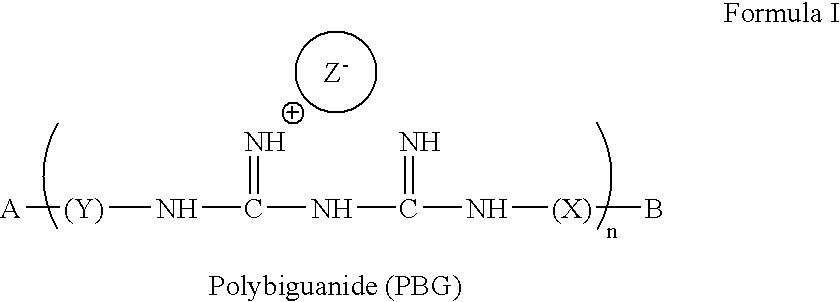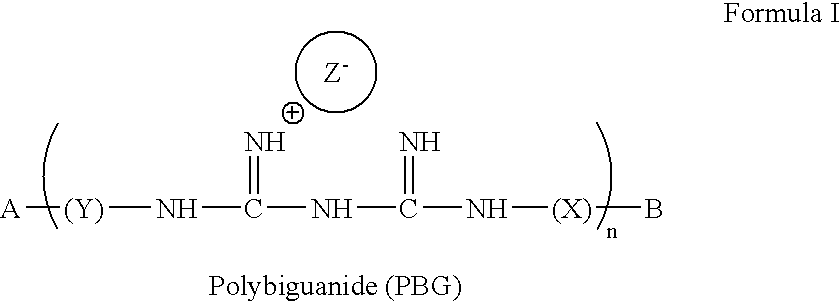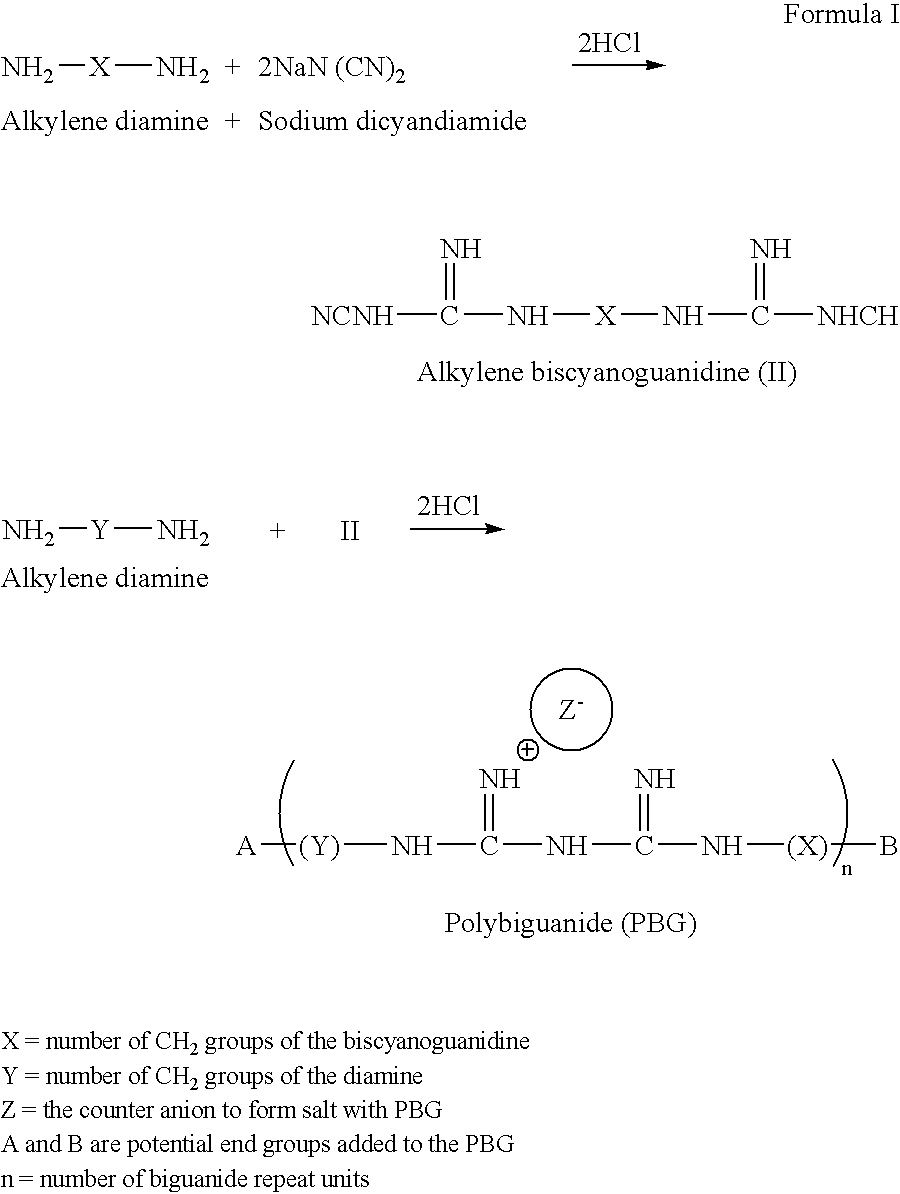Method for the treatment or prevention of virus infection using polybiguanide-based compounds
a technology of polybiguanide and compound, which is applied in the direction of antibacterial agents, instruments, biocide, etc., can solve the problems of ineffective existing therapies, affecting the survival rate of HIV-1, and affecting the effectiveness of existing therapies, so as to achieve low mammalian toxicity, low toxicity, and high activity
- Summary
- Abstract
- Description
- Claims
- Application Information
AI Technical Summary
Benefits of technology
Problems solved by technology
Method used
Image
Examples
example 1
Synthesis of Biguanide Compounds
[0119] The PBGs of this invention are readily prepared by reacting biscyanoguanides with diamino compounds in the presence of sufficient protic acids to form the polymer carried out in the neat or by using suitable solvent. The end group modifications (mono or di types) can be accomplished either by a post reaction after the initial polymer is formed, or simultaneously during the formation of the polybiguanide. All these syntheses are described in British patents numbered 1,167,249; and 1,531,717; and U.S. Pat. Nos. 4,891,423; 5,741,886; and patent application publication 2003 / 0032768 A1. The synthesis of mono end-capped PBGs is readily described in U.S. Pat. No. 5,741,886 while that of di-end capped PBGs is described in US 2003 / 0032768 A1.
[0120] The present invention provides compounds of formula (I): 3
[0121] The first line of the equation describes the synthesis of the biscyanoguanidine reactant, while the second shows the reaction of the diamino co...
example 2
Cytotoxicity Analysis of Polybiguanide Compounds
[0130] A. Monomeric Biguanides and Bis-Biguanides.
[0131] HeLa cells (ATCC designation CCL-2) were maintained in Dulbecco's Modified Eagle's medium (DMEM). P4-CCR5 (P4R5 cells) (AIDS Reagent Program #3580) were cultured in DMEM with 0.1 ug / ml puromycin as described by Charneau et al. (1994 J. Mol. Biol. 241:651-652). Sup-Ti human T lymphocytes (ATCC designation CRL-1942) were cultured in RPMI 1640. All three cell types were cultured in media supplemented with 10% fetal bovine serum (FBS), L-glutamate (0.3 mg / ml), antibiotics (penicillin, streptomycin, and kanamycin at 0.04 mg / ml each), and 0.05% sodium bicarbonate. Cells of the Vk2 / E6E7 human vaginal karatinocyte cell line were cultured as described by Fichorova et al. (1997 Biol. Reprod. 57:847-855).
[0132] As part of our initial efforts to design and test PBG-based compounds optimized for cytotoxicity and anti-HIV-1 activity, experiments were performed with small molecules that contain...
see example 3b
[0137]
[0138] D. Toxicity of Polybiguanides with Modified End Caps.
[0139] See Example 3C.
[0140] E. Toxicity of Polybiguanides in Primary Vaginal Keratinocytes.
[0141] As described above the effect of PEHMB and related compounds on P4R5 cell viability after a two-hour exposure to the compound was compared to the effects of control compounds such as N-9. In those experiments (Table 3) the PBG compounds were usually substantially less toxic than N-9. To further evaluate the effect of this class of compound on various types of cells (in particular PEHMB P4-R5 cells, ME-180 cells (ATCC HTB-33; cervical epidermoid carcinoma), VK2 / E6E7 human vaginal cell line (Fichorova et al. 1997 Biol. Reprod. 57:847-855), and human primary vaginal karatinocytes (isolated from tissues obtained from vaginal reconstructive surgery)) the compounds were incubated with the different cells for various lengths of time before assessment of cell viability. The results from these experiments are presented in Table 4...
PUM
| Property | Measurement | Unit |
|---|---|---|
| Mass | aaaaa | aaaaa |
| Mass | aaaaa | aaaaa |
| Mass | aaaaa | aaaaa |
Abstract
Description
Claims
Application Information
 Login to View More
Login to View More - R&D
- Intellectual Property
- Life Sciences
- Materials
- Tech Scout
- Unparalleled Data Quality
- Higher Quality Content
- 60% Fewer Hallucinations
Browse by: Latest US Patents, China's latest patents, Technical Efficacy Thesaurus, Application Domain, Technology Topic, Popular Technical Reports.
© 2025 PatSnap. All rights reserved.Legal|Privacy policy|Modern Slavery Act Transparency Statement|Sitemap|About US| Contact US: help@patsnap.com



